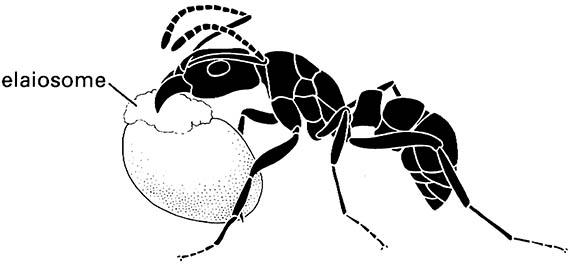11.3.2. Myrmecochory: seed dispersal by ants
Many ants are seed predators that harvest and eat seeds (section 11.2.5). Seed dispersal may occur when seeds are accidentally lost in transport or seed stores are abandoned. Some plants, however, have very hard seeds that are inedible to ants and yet many ant species actively collect and disperse them, a phenomenon called myrmecochory. These seeds have food bodies, called elaiosomes, with special chemical attractants that stimulate ants to collect them. Elaiosomes are seed appendages that vary in size, shape, and color and contain nutritive lipids, proteins, and carbohydrates in varying proportions. These structures have diverse derivations from various ovarian structures in different plant groups. The ants, gripping the elaiosome with their mandibles (Fig. 11.9), carry the entire seed back to their nest, where the elaiosomes are removed and typically fed to the ant larvae. The hard seeds are then discarded, intact and viable, either in an abandoned gallery of the nest, or close to the nest entrance in a refuse pile.
Myrmecochory is a worldwide phenomenon, but is disproportionately prevalent in three plant assemblages: early flowering herbs in the understorey of north temperate mesic forests; perennials in Australian and southern African sclerophyll vegetation; and an eclectic assemblage of tropical plants. Myrmecochorous plants number more than 1500 species in Australia and about 1300 in South Africa, whereas only about 300 species occur in the rest of the world. They are distributed amongst more than 20 plant families and thus represent an ecological, rather than a phylogenetic, group, although they are predominantly legumes.
This association is of obvious benefit to the ants, for which the elaiosomes represent food; and the mere existence of the elaiosomes is evidence that the plants have become adapted for interactions with ants. Myrmecochory may reduce intraspecific and/or inter- specific competition amongst plants by removing seeds to new sites. Seed removal to underground ant nests provides protection from fire or seed predators, such as some birds, small mammals, and other insects. Postfire South African fynbos (plant) community structure varies according to the presence of different seed dispersing ants (Box 1.2). Furthermore, ant nests are rich in plant nutrients, making them better microsites for seed germination and seedling establishment. However, no universal explanation for myrmecochory should be expected, as the relative importance of factors responsible for myrmecochory must vary according to plant species and geographical location.
Myrmecochory can be called a mutualism, but specificity and reciprocity do not characterize the association. There is no evidence that any myrmecochorous plant relies on a single ant species to collect its seeds. Similarly, there is no evidence that any ant species has adapted to collect the seeds of one particular myrmecochorous species. Of course, ants that harvest elaio- some-bearing seeds could be called a guild, and the myrmecochorous plants of similar form and habitat also could represent a guild. However, it is highly unlikely that myrmecochory represents an outcome of diffuse or guild coevolution, as no reciprocity can be inferred. Elaiosomes are just food items to ants, which display no obvious adaptations to myrmecochory. Thus, this fascinating form of seed dispersal appears to be the result of plant evolution, as a result of selection from ants in general, and not of coevolution of plants and specific ants.


